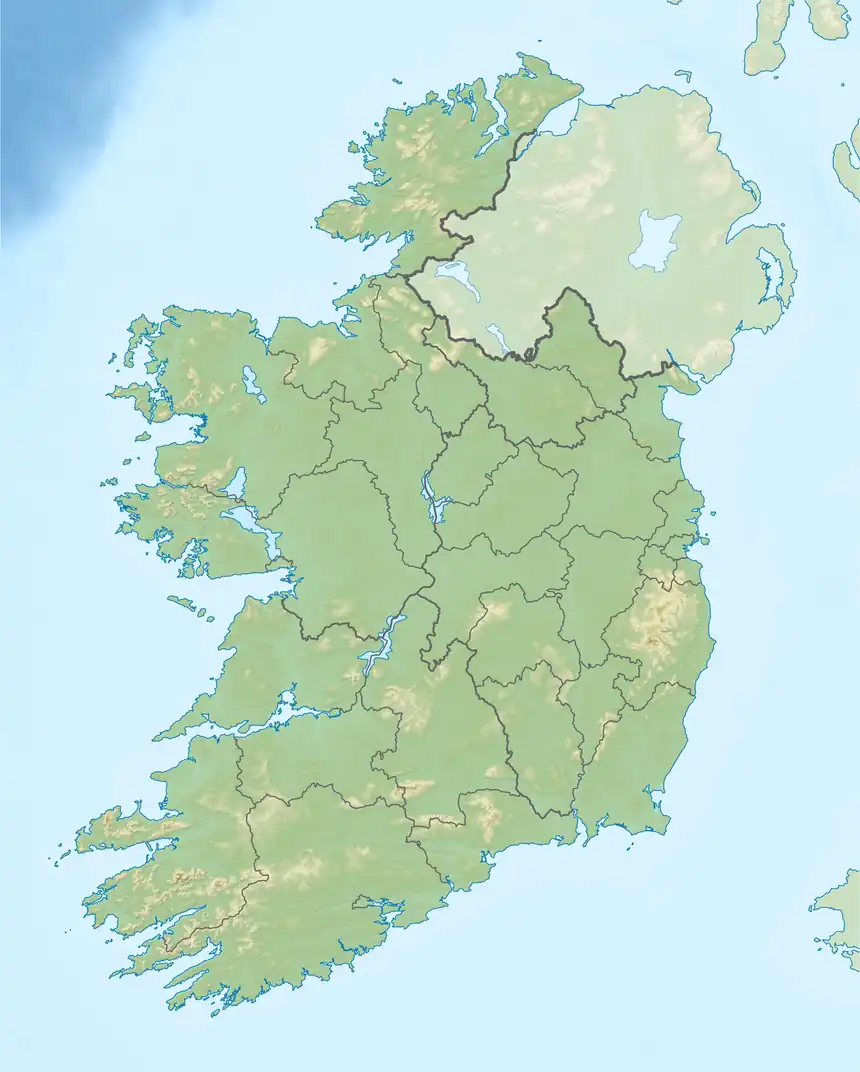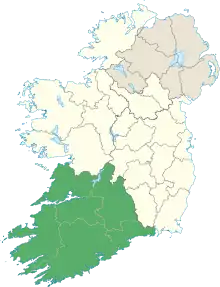Caher West Top
Caher West Top (Irish: Cathair na Féinne, meaning 'stone fort of the Fianna')[2] at 973.4 metres (3,193 ft 7 in), is the fifth-highest peak in Ireland on the Irish Vandeleur-Lynam classification, and part of the MacGillycuddy's Reeks range. Caher West Top is the only Furth to have a prominence below 30 metres (98 ft).
| Caher West Top | |
|---|---|
 Caher West Top from Caher | |
| Highest point | |
| Elevation | 973.4 m (3,194 ft)[1] |
| Prominence | 24.05 m (78.9 ft)[1] |
| Listing | Vandeleur-Lynam, Furth |
| Coordinates | 51°59′43″N 9°45′45″W[1] |
| Geography | |
 Caher West Top | |
| Parent range | MacGillycuddy's Reeks |
| OSI/OSNI grid | V790840 |
| Topo map | OSI Discovery 78 |
| Geology | |
| Mountain type | Purple sandstone & siltstone, (Ballinskelligs Sandstone Formation)[1] |
Geography
_-_geograph.org.uk_-_1434483.jpg.webp)
The mountain is located about 500 metres west of Caher East Top and is part of the MacGillycuddy's Reeks of County Kerry.[3] Caher West Top is often climbed as part of the Coomloughra Horseshoe, which takes 6-8 hours and is described as "one of Ireland’s classic ridge walks".[4] The horseshoe takes in other neighbouring peaks such as Carrauntoohil, Beenkeragh, The Bones (including the Beenkeragh Ridge), Skregmore, and Cnoc Iochtair.[5]
Climbers refer to the narrow path that runs along the top of Caher West Top and neighboring Caher, as Caher Ridge.[6][7]
Caher West Top is regarded by the Scottish Mountaineering Club ("SMC") as one of 34 Furths, which is a mountain above 3,000 ft (914.4 m) in elevation, and meets the other SMC criteria for a Munro (e.g. "sufficient separation"), but which is outside of (or furth) Scotland;[8] which is why Caher West Top is sometimes referred to as one of the 13 Irish Munros; it is the only one of the 34 Furths on the official SMC list that has a topographic prominence below 30 metres (98 ft 5 in).[9]
Because of Caher West Top's low prominence, it does not appear in the Irish Arderin classification, or the British Isles Simm and Hewitt classifications.[10] Caher West Top does also not appear in the MountainViews Online Database, 100 Highest Irish Mountains, as the prominence threshold is 100 m (328 ft 1 in).[11]

See also
References
- MountainViews: Caher West Top
- Tempan, Paul (February 2012). "Irish Hill and Mountain Names" (PDF). MountainViews.ie.
- Caher West Top maps at www.themountainguide.co.uk. Accessed on 5 Feb 2013.
- "Route Descriptions". Kerry Mountain Rescue Teams. 2018.
- Dillon, Paddy (1998). Exploring the South of Ireland. Ward Lock. ISBN 0-7063-7566-1.
- Ryan, Jim (2006). Carrauntoohil and MacGillycuddy's Reeks: A Walking Guide to Ireland's Highest Mountains. Collins Press. ISBN 978-1905172337.
- "Hiking Carrauntoohil: Everything you Need to Know". Outside.ie. 2017.
The trail will take you along the really scenic Caher Ridge Path with great views and takes in the summit of the Caher Mountain, before you descend a little to the col on the way to Carrauntoohil.
- Mountains – Key Facts. The Munros, Corbetts, Grahams, Donalds & Furths Archived 2012-08-22 at the Wayback Machine at www.smc.org.uk. Accessed on 5 Feb 2013.
- "Hill Lists: Furths". Scottish Mountaineering Club.
The list of peaks of 3000ft or more within the United Kingdom and the Republic of Ireland outside (furth) of Scotland. There are currently 34 Furths.
- Cocker, Chris; Jackson, Graham (2018). "The Database of British and Irish Hills". Database of British and Irish Hills.
- Mountainviews, (September 2013), "A Guide to Ireland's Mountain Summits: The Vandeleur-Lynams & the Arderins", Collins Books, Cork, ISBN 978-1-84889-164-7
External links
- MountainViews: The Irish Mountain Website, Caher West Top
- MountainViews: Irish Online Mountain Database
- The Database of British and Irish Hills , the largest database of British Isles mountains ("DoBIH")
- Hill Bagging UK & Ireland, the searchable interface for the DoBIH
- Ordnance Survey Ireland ("OSI") Online Map Viewer
- Logainm: Placenames Database of Ireland

